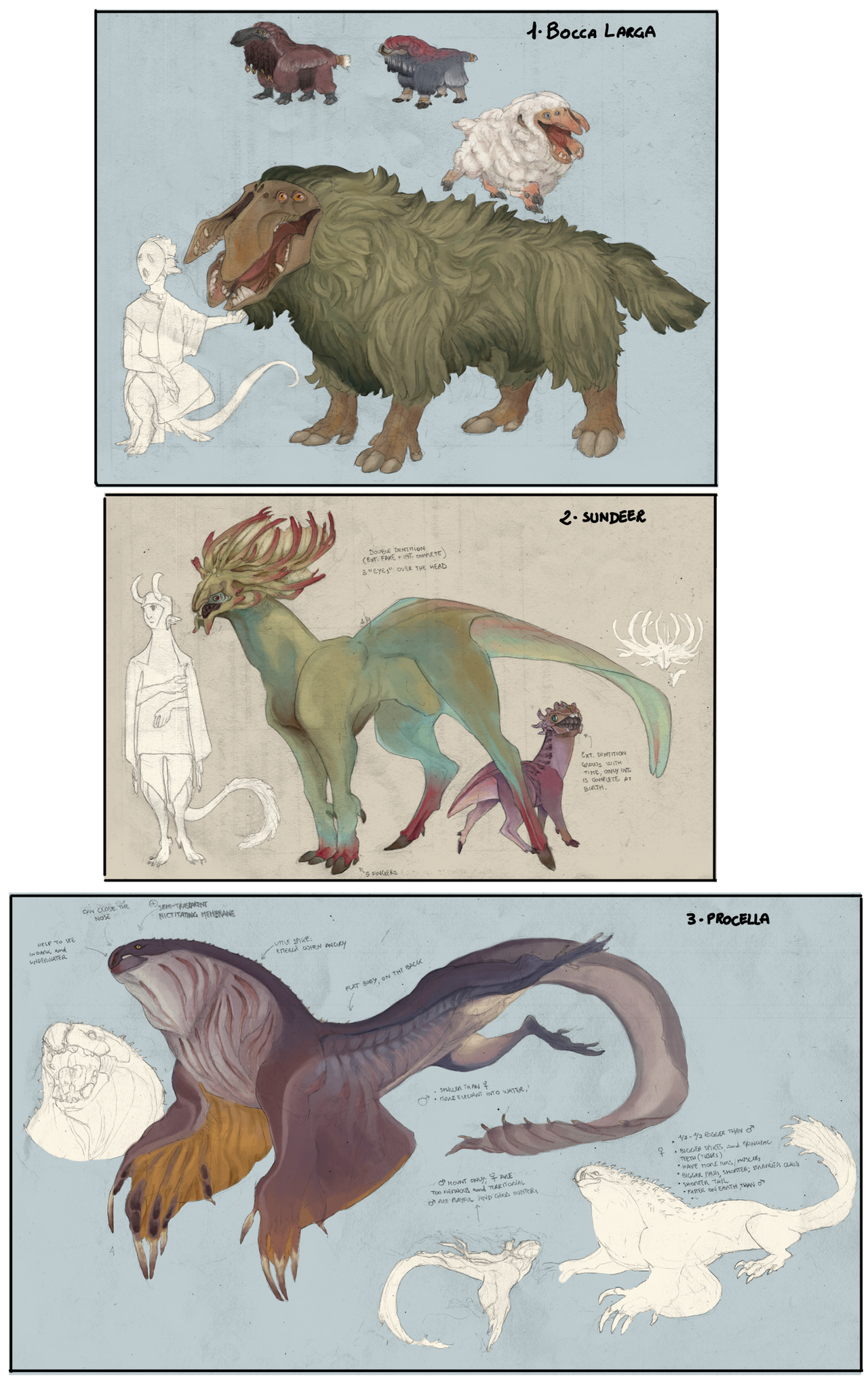HOME | DD
 42Ly — Random species for an alien planet - Mounts
42Ly — Random species for an alien planet - Mounts

#alien #creatures #fantasy #42ly
Published: 2021-04-30 20:54:40 +0000 UTC; Views: 25894; Favourites: 358; Downloads: 14
Redirect to original
Description
Even more entries for the april prompt of the species Yevat: www.deviantart.com/yokamyceliu…Very rough, and terribly incorrect. Below, a brief description for each of them (apologies for any error that might be present).
1 - Bocca Larga: big wooly creature, that lives in the forest. It's bushy fur can host lichen, moss and small creatures, in the wildlife individuals, assuming a greenish or brown hue. Has four eyes and three tongues (one principal, two lateral secondaries). The formidable resisten bone structure of the mouth can be open very wide due to the elastic structures that connect the different parts of the skull (centrally, and in the angles of the mouth). It's difficult to say if it's more dangerous a bite of this creature, or a charge of its massive body. Males are slightly bigger than females and have longer furs, for the rest there're no big differences.
The cubs are playful, and the extreme thick of their fur protect them almost completely from predators aggressions. With time the thick of the fur reduce (relatively speaking), the body stretches, the skull is reinforced and they finally develop all the teeth inside the oral cave (secondary incisors, and multiple little teeth inside the mouth that allows a better grip with the bite and compense the big cave space inside that mouth due to the the strench of the skull).
Tamed creatures present longer and more colored fur than wild individuals, and they're ofthen braided in fantastic styles. They're not particularly aggressive, unless you decide to step between two fighting males or approach a cub (watch out for the mother!)
2 - Sundeer: strange colorful creatures, characterized by a double dentition (external has white/light teeth, incisors only; internal has a complete dentition of black/dark teeeth); on the forehead there're also three additional eyes, that only sense light and its intensity. The external skull produces horn-like structures that, with time, grow into a complicate structure connected by a semi-trasparent membrane. The horns are resistent but hollow inside, to allow the passage of blood vases, nerves and air canals all immersed into lymphatic liquid (it's infact here that these creatures has the majority of their linfatic tissue and structures). These horns are the base of the life for these creatures: adults without horns or damaged cannot live long: they breath through it, half of their nutrition is provided by the membrane (where specialized cells react to sunlight and produce energy through a process similar to photosynthesis), the principal center of their immune system is there, it's an important element for their termoregulation... The tails is semi-trasparent, and have few not important centers that fulfill part of the same functions of the horns membrane but are totally secondaries and almost irrelevant. Frontal paws has two thumbs and three fingers of different size (from inside to outside: small-medium, big, and very small); posterior has a single hoof and two dewclaws.
These creatures live into the forests, but every now and then like to go underground (just not too much) to have a refreshing swim. Once per year they traverse the desert in big packs, to take new home on the other side forests; the ritual is repeated the next year, and each group folows specific routes that they learned and pass on through generations.
At birth, cub don't have the horn structure nor the external dentition; but, while they almost immediately start to grow the first, the second appear very late and only after few years.
These creatures are good resistant runner, capable of little sprint for small traits; their defense is into the numbers, so it's usual for them to move and live in big colored packs. It's easy to tame one, and they're not particulair shy.
3 - Procella: aquatic creatures, can stay underwater for medium-long periods of time, then they need to go back to surface to refill their air reserves. On the back they've small spikes that completely emerge when the creature want to fight or is frightened. The tongue has two tips, and the tail presents eight small claws at its end (maybe sign of the fact that originally it wasn't a tail but two separated limbs, that with time and evolution fused together to abetter adapt to the underwater life). Have a semi-trasparent nictitating membrane, and can seal the nose before going underwater; the neck and sides are characterized with narrowings that sign where the air is gather and that can expand outiside for particulair intense efforts and air gatherimgs.
Females are bigger than males, present larger and bigger spikes over the back, have more muscles and thicker claws, bigger canines, a shorter tail, and less extended and curved flippers. They stay longer out of water, are more easily irritable, way too nervous and extremely territorial. Males, on the contrary, are more playful and curious, and better and more elegant swimmers; plus, their spikes are smaller, and their back is almost flat. Therefore, only males are actually used as mounts.
Yevat species by YokaMycelium
Art and designs by me
Related content
Comments: 10

👍: 2 ⏩: 1

👍: 0 ⏩: 0

👍: 0 ⏩: 0

👍: 0 ⏩: 0

👍: 0 ⏩: 0

👍: 0 ⏩: 1

👍: 0 ⏩: 1

👍: 0 ⏩: 0

👍: 1 ⏩: 1

👍: 1 ⏩: 0

























